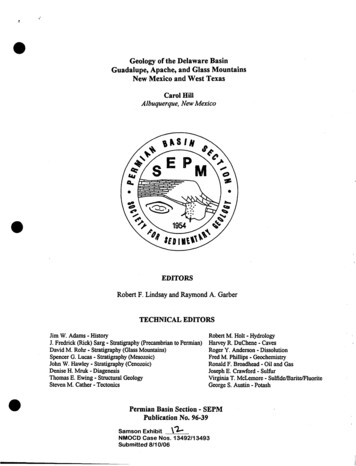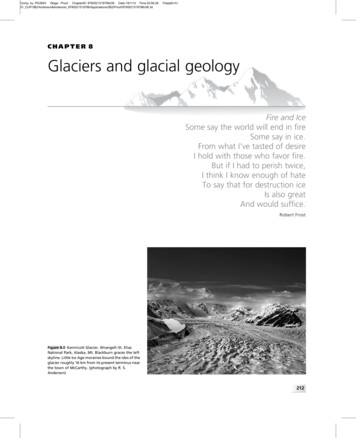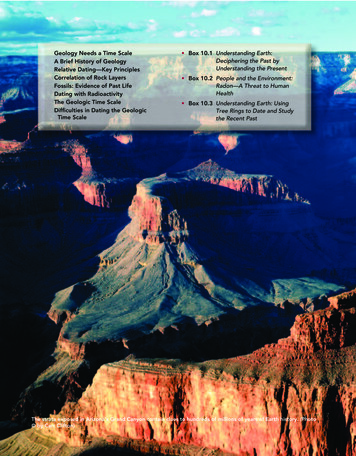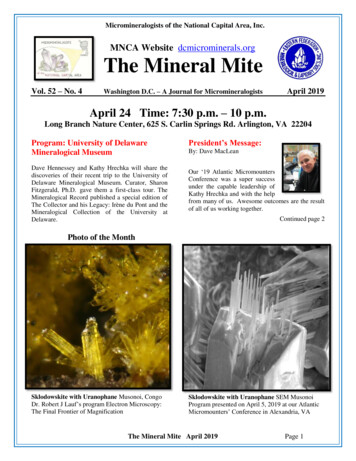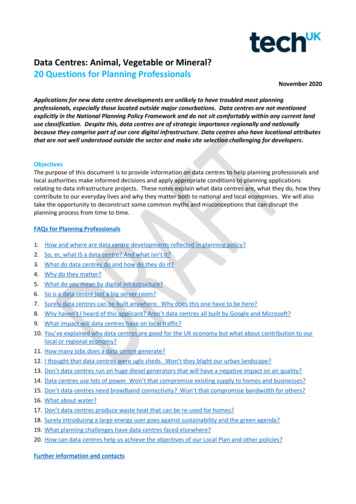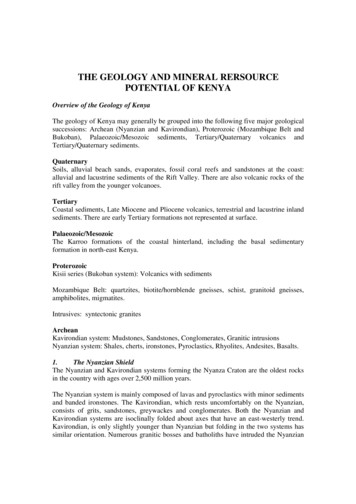
Transcription
THE GEOLOGY AND MINERAL RERSOURCEPOTENTIAL OF KENYAOverview of the Geology of KenyaThe geology of Kenya may generally be grouped into the following five major geologicalsuccessions: Archean (Nyanzian and Kavirondian), Proterozoic (Mozambique Belt andBukoban), Palaeozoic/Mesozoic sediments, Tertiary/Quaternary volcanics andTertiary/Quaternary sediments.QuaternarySoils, alluvial beach sands, evaporates, fossil coral reefs and sandstones at the coast:alluvial and lacustrine sediments of the Rift Valley. There are also volcanic rocks of therift valley from the younger volcanoes.TertiaryCoastal sediments, Late Miocene and Pliocene volcanics, terrestrial and lacustrine inlandsediments. There are early Tertiary formations not represented at surface.Palaeozoic/MesozoicThe Karroo formations of the coastal hinterland, including the basal sedimentaryformation in north-east Kenya.ProterozoicKisii series (Bukoban system): Volcanics with sedimentsMozambique Belt: quartzites, biotite/hornblende gneisses, schist, granitoid gneisses,amphibolites, migmatites.Intrusives: syntectonic granitesArcheanKavirondian system: Mudstones, Sandstones, Conglomerates, Granitic intrusionsNyanzian system: Shales, cherts, ironstones, Pyroclastics, Rhyolites, Andesites, Basalts.1.The Nyanzian ShieldThe Nyanzian and Kavirondian systems forming the Nyanza Craton are the oldest rocksin the country with ages over 2,500 million years.The Nyanzian system is mainly composed of lavas and pyroclastics with minor sedimentsand banded ironstones. The Kavirondian, which rests uncomfortably on the Nyanzian,consists of grits, sandstones, greywackes and conglomerates. Both the Nyanzian andKavirondian systems are isoclinally folded about axes that have an east-westerly trend.Kavirondian, is only slightly younger than Nyanzian but folding in the two systems hassimilar orientation. Numerous granitic bosses and batholiths have intruded the Nyanzian
and Kavirondian. The Kavirondian intrusions were more but the pre-Kavirondian werealso widespread and the two systems are discernible.2.Mozambique BeltThe Mozambique belt is a structural unit within which a wide variety of metasedimentary and meta-igneous rocks are found showing a broad concordance of structuralstyle and metamorphic history. In most of these rocks, the degree of deformation isintense and is of high metamorphic grades. They were thus referred to earlier in literatureas the basement system rocks, due to high degree of metamorphism and deformation.Recent work on the Mozambique Belt has shown that rocks can be sub-divided intogroups of contrasting lithology, structure and composition of igneous rocks content.These groups are being studied in greater detail in order to come up with properchronostratigraphic terminology.Within the Mozambique Belt basic igneous complexes are found and range in size frombosses to small dykes. They occur both east and west of the Rift Valley. Some of theolder basic intrusions have undergone deformation and metamorphism to give orthoamphibolites and charnockitic gneisses.Basic and granitic intrusions are known in the Mozambique Belt. The most characteristicfeature of the Mozambique Belt is its structural trend which is more or less north-south inits entire belt.Variations of the northerly trend are minor and when observed can be explained and arelocalised. The majority of Mozambique rocks have been placed in upper Precambrian(Proterozoic).3.Palaeozoic and Mesozoic FormationsPalaeozoic and Mesozoic formations in Kenya are found near the coast and in northeastern Kenya. The earliest of these rocks are Permo-Carboniferous which are mostlysandstones and shales that form the Duruma series. This is equivalent to the Karroosystem in Southern Africa. The local formations are Taru; Maji-ya-Chumvi; Mariakaniand the Mazeras. They extend for about 100 kilometres from Taru to Mazeras, west ofMombasa. The rocks dip very gently towards the ocean and are heavily faulted in places.Mesozoic rocks occur in two separate areas, in the north-east part of Kenya and along theCoast belt. The sratigraphy and fossils in the two areas are very distinct and it is likelythat the sedimentary basins in the two areas were connected. Revision mapping in thearea has come up with interesting lithological units that have revised lithological names.4.Tertiary and Quaternary VolcanicsVolcanic rocks cover the central parts of the country from south to north, occurring in thefloor of the Rift Valley and on the peneplains west and east of the valley.
The oldest of the volcanics are of Lower Miocene age and comprise the eroded lavas andpyroclastic piles of South Nyanza. Late in Miocene times, Kapiti and Yatta phonoliteswere erupted and flowed to great lengths.Further eruptions accompanied by faulting persisted and also gave rise to the Rift Valleyand the volcanic piles of Mounts Kenya, Elgon and Kilimanjaro.Quaternary volcanism was mostly within the Rift Valley and has given rise to the cratersand cider cones that are found in the floor of the valley e.g. Longonot, Menengai andSuswa.5.Tertiary and Quaternary SedimentsThere are many deposits of sediments in various parts of Kenya. They usually occur atthe base of volcanic succession, intercalated with it or occurring in tectonic troughs.The repeated faulting of the Rift Valley floor and the numerous volcanic eruptionscreated many short-lived basins of internal drainage in which lacustrine and fluviatilesediments accumulated. Most of these sediments are unfossiliferous, but a few are ofinterest as they contain deposits that bear artefacts and interesting fossils that have beenstudied extensively.The more important sediments of middle Pleistocene are the Olorgesaillie lakebeds, alacustrine series with much diatomite, mammalian fossils and artefacts. This is alsocomparable to the Kariandusi sediments near Gilgil and the Kanjera Beds in theKavirondo Gulf off Lake Victoria. Olorgesaillie beds and Kariandusi sediments are in theRift Valley.
Overview of mineral occurrenceA wide range of minerals, both metallic and industrial, are known to occur in the country.These include barite, gypsum, gold, silver, lead, talc, titanium, salt, a variety ofgemstones, (mainly ruby and several varieties of garnets) dimension stones, silica sand,heavy mineral sands, manganese, zinc, wollastonite, graphite, kaolin, copper, nickel,chromite, pyrite, various clays, rare earth elements and pyrochlore.The Geological environments for the mineralization can be summarised as follows:(a)The Archean Nyanzian Craton area of Western Kenya where metallicmineralization of base and precious metals are known to occur: gold, copper and silverhave been mined in the past. They are also potential for ferrous and no-ferrous metals.Kimberlitic bodies have also been reported.(b)The Proterozoic Mozambique Belt that is most extensive in Central Kenyanorth to South in which minerals such as kyanite, corundum, graphite, wollastonite,marble, asbestos, fluorspar, magnesite, kaolin and a variety of gemstones are foundtogether with minerals associated with basic and granitic rocks.(c)The sedimentary rocks of Palaeozoic to Quaternary are widespread. These rocksare sources and hosts of limestone, gypsum, clays, manganese and constructionmaterials and possibly hydrocarbons. Base metal mineralization, lead-zinc-barite andcopper are known to occur in the sedimentary basin along the coastal belt.Heavy mineral sands also occur along the coastal beach sands and Recent deposits ofabout 3.2 billion tons of titanium bearing have been discovered.(d)The volcanic rocks associated with Rift System host a variety of minerals andconstruction materials. The volcano-sedimentary accumulations have deposits of clays,evaporites, trona (soda ash), diatomite, natural carbon dioxide, kunkar and gypsum.Gem quality rubies have recently been discovered.Carbonatites are known to be host of several minerals found in the Nyanzian shield area,around Lake Victoria shores and in the southern part of the coastal sedimentary basin.Mrima, one of the carbonatites known for potential of niobium and rare earth elements(REE) is found in the coastal basin, south of Mombasa.
Volcanic rocks cover the central parts of the country from south to north, occurring in the floor of the Rift Valley and on the peneplains west and east of the valley. The oldest of the volcanics are of Lower Miocene age and comprise the eroded lavas and pyroclastic piles of South N
